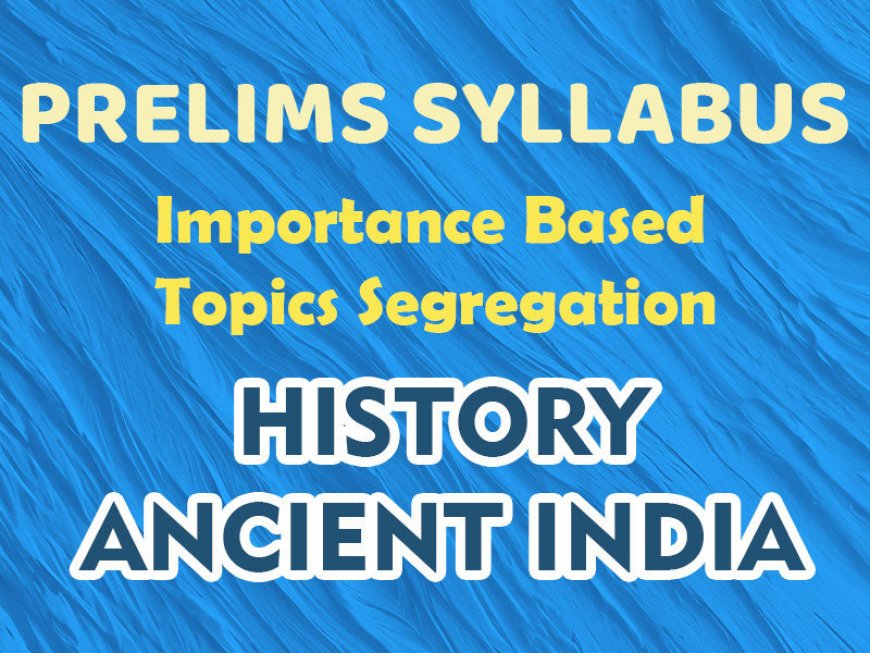Pre - Syllabus - Importance Based - History-Ancient India
Pre - Syllabus - Importance Based - History-Ancient India

Stone Age Cultures (5-7)
· Palaeolithic Age (3-5)
o Hunter-gatherer lifestyle
o Tool-making techniques
· Mesolithic Age (1-3)
o Transition period
o Microliths
· Neolithic Age (3-5)
o Beginning of agriculture
o Settlements and pottery
Chalcolithic Cultures (3-5)
- Ahar-Banas Culture (1-3)
- Jorwe Culture (1-3)
Urban Planning and Architecture (9-11)
· City Layouts (5-7)
o Grid pattern
o Drainage systems
· Major Sites (7-9)
o Harappa, Mohenjo-Daro, Dholavira, Lothal
· Public Buildings (3-5)
o Great Bath
o Granaries
Economic and Social Life (7-9)
· Agriculture and Trade (5-7)
o Crops cultivated
o Trade relations (Mesopotamia)
· Crafts and Technologies (5-7)
o Bead-making
o Metallurgy
· Seals and Script (5-7)
o Undeciphered script
o Pictographic seals
Religion and Decline (5-7)
· Religious Practices (3-5)
o Mother Goddess worship
o Animal worship
· Theories of Decline (5-7)
o Climate change
o Aryan invasion theory
Early Vedic Period (Rig Vedic Age) (7-9)
· Society and Economy (5-7)
o Pastoral lifestyle
o Tribal assemblies (Sabha and Samiti)
· Religious Practices (3-5)
o Nature worship
o Rig Veda hymns
Later Vedic Period (7-9)
· Societal Changes (5-7)
o Varna system solidification
o Emergence of kingdoms
· Economic Developments (3-5)
o Agriculture expansion
o Use of iron tools
· Religious Evolution (3-5)
o Ritualistic practices
o Upanishads philosophy
Age of Mahajanapadas (9-11)
· Sixteen Mahajanapadas (5-7)
o Notable ones: Magadha, Kosala, Vatsa, Avanti
· Political Developments (5-7)
o Republican states
o Rise of Magadha
Rise of Jainism and Buddhism (15-17)
· Jainism (7-9)
o Vardhamana Mahavira's teachings
o Triratnas (Three Jewels)
· Buddhism (15-17)
o Gautama Buddha's life and teachings
o Four Noble Truths and Eightfold Path
o Spread of Buddhism
· Impact on Society (5-7)
o Challenge to Vedic rituals
o Influence on art and architecture
Chandragupta Maurya (7-9)
· Establishment of the Empire (5-7)
o Defeat of the Nandas
o Role of Chanakya (Kautilya)
· Administration (5-7)
o Centralized governance
o Arthashastra's insights
Bindusara (1-3)
· Expansion of the Empire (1-3)
o Southern conquests
Ashoka the Great (17-19)
· Kalinga War and Transformation (7-9)
o Causes and consequences
· Dhamma Policy (9-11)
o Edicts and inscriptions
o Promotion of Buddhism
· Administration and Legacy (7-9)
o Spread of Buddhism abroad
o Ashokan pillars and stupas
Mauryan Administration and Economy (9-11)
· Provinces and Bureaucracy (5-7)
· Economic Activities (5-7)
o Agriculture and taxation
o Trade routes (Uttarapatha and Dakshinapatha)
Shungas and Kanvas (3-5)
· Cultural Contributions (1-3)
o Patanjali's Mahabhashya
Indo-Greeks, Shakas, and Kushanas (9-11)
· Indo-Greeks (1-3)
o Coins and Hellenistic influence
· Shakas (1-3)
o Western India rule
· Kushanas (5-7)
o Kanishka's reign
o Gandhara and Mathura schools of art
Satavahanas (5-7)
· Political Expansion (3-5)
· Cultural Developments (3-5)
o Amaravati Stupa
o Prakrit literature
Golden Age of India (17-19)
· Chandragupta I (1-3)
o Foundation of the empire
· Samudragupta (7-9)
o Conquests and 'Napoleon of India'
o Allahabad Pillar Inscription
· Chandragupta II (Vikramaditya) (9-11)
o Expansion and prosperity
o Fa-Hien's visit
Administration and Society (11-13)
· Administrative System (5-7)
o Decentralization
o Land grants
· Economic Prosperity (5-7)
o Trade with Roman Empire
o Coinage system
· Cultural Achievements (15-17)
o Art and architecture (Ajanta caves)
o Literature (Kalidasa's works)
o Science and technology (Aryabhata)
Harshavardhana (5-7)
· Political Unification (3-5)
o Capital at Kannauj
· Cultural Contributions (3-5)
o Patronage of Nalanda University
o Hiuen Tsang's accounts
South Indian Kingdoms (9-11)
· Pallavas (3-5)
o Architecture (Mahabalipuram)
· Chalukyas (3-5)
o Badami cave temples
· Rashtrakutas (3-5)
o Ellora caves
o Contributions to art
· Bhimbetka Caves (1-3)
o Significance of rock paintings
· Samhitas, Brahmanas, Aranyakas, Upanishads (3-5)
o Contents and philosophical concepts
· Sungas and Kanvas (1-3)
o Political events
· Chedi and Chera Kingdoms (1-3)
· Iranian and Macedonian Invasions (1-3)
o Impact on Indian polity and society
· Literature (3-5)
o Sangam texts
· Economy and Society (1-3)
o Trade and urban centers
· Medical Science (Ayurveda) (1-3)
· Mathematics and Astronomy (1-3)
o Works of Varahamihira and Brahmagupta
· Six Schools of Indian Philosophy (1-3)
o Sankhya, Yoga, Nyaya, Vaisheshika, Mimamsa, Vedanta
